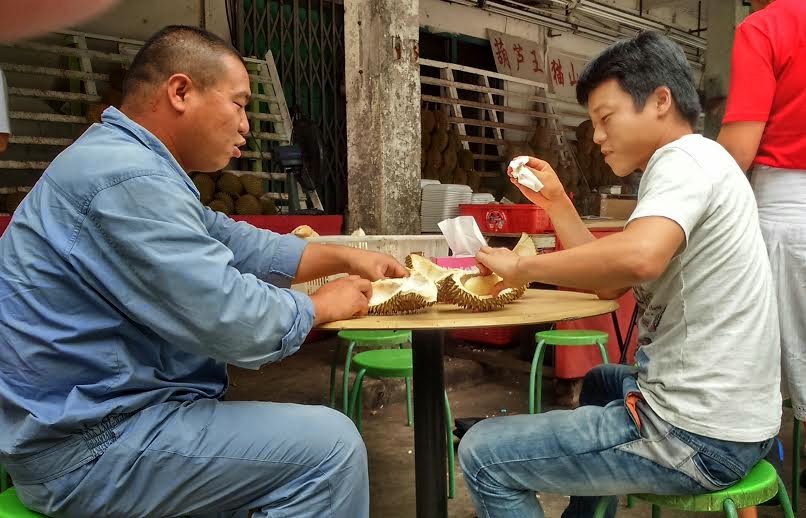 There's nothing that causes more debate in Singapore than one's opinion about this prickly fruit.
There's nothing that causes more debate in Singapore than one's opinion about this prickly fruit.As one local told me yesterday,"You
love it, or you hate it. There's no
in between."
Since I'm going to be teaching here for the next three years, I needed to formulate my own opinion, meaning I had to directly partake of the beloved/abhorred ... durian.
The fruit is offered for sale throughout the country, but I wanted the authentic durian experience. My friend Nora said actually that's not possible in Singapore because the fruit, like almost everything else, is imported. It's grown in several sites in Southeast Asia, but most of the Singaporean fruit comes from neighboring Malaysia.
When she was a girl, Nora said her family had a farm in Malaysia with some durian trees. She said the fruit can't be cut from the branches, but, instead, has to fall on its own when the fruit is ripe.
"Some nights we'd hear the durians hitting our roof, and I knew we'd have a feast the next day," she said.
I'm not about to travel to Malaysia to eat a piece of fruit, so I opted for the next best thing - asking my Singaporean friend Joseph to take me to a durian stand that he liked.
There are many varieties of durians, but the basic question is whether one prefers a more bitter durian or a sweeter one. We decided to select the most popular durian in Sinapore, a sweet variety known as a "king" durian.
Royalty has its price. Our 2.2 kilogram "king" (4.8 pounds) cost $70 Singaporean dollars ($56 US dollars). Durians won't be added to my list of staples anytime soon.
The next step in the durian process is for the vendor to slice open the tough, spiky, outer husk,
revealing this yellow meat in the upper and lower half of the fruit.
That's it. The white core isn't edible.
At this point, most people just dive in with their fingers.
It was now my turn, and I, too, grabbed a large chunk, popping it into my mouth. The best way I can describe the texture is something similar to custard. In all my years, I've never run across a custard-like fruit, which is why it felt so odd as I began eating it. Suddenly, the sweetness exploded in my mouth.
Hmmm.....sweet custard.
It was definitely unlike anything I'd ever tasted.
In 1856, British naturalist Alfred Russel Wallace wrote this famous description of the taste, "a rich custard highly flavoured with almonds gives the best general idea of it, but there are occasional wafts of flavour that call to mind cream-cheese, onion-sauce, sherry-wine, and other incongruous dishes. Then there is a rich glutinous smoothness in the pulp which nothing else possesses, but which adds to its delicacy. It is neither acid nor sweet nor juicy; yet it wants neither of these qualities, for it is in itself perfect."
I agree with Alfred about the custard taste, but that's it. I hated it.
It's not that my palate is non-adventurous. Last week, I loved the barbeque stingray, and later, after trying a durian, I sampled frog legs for the first time, which I also enjoyed. It's just that durians and I disagree.
Still, sitting around a table at the durian stand, devouring the fruit is a culinary delight for many Singaporeans, and yes, it's possible to take the durian home, but there's a problem with how to transport the famous fruit because there's one thing that almost everyone, fans and haters alike, can agree on about durians - they smell horrible.
Cut or uncut. The odor is overwhelming or pick another adjective: awful, nauseating, vial, disgusting.
I found numerous descriptions on the internet to capture the essence of the aroma: rotting flesh, raw sewage, vomit, cat urine, sweaty gym socks, decaying garbage....You get the idea.
It's an aroma that grabs one's attention from yards away. As I write this blog entry, the odor of the fruit that I consumed 18 hours ago still permeates my fingers. Yuk!
For some reason, Singaporeans just don't want to be around the smell of rotting flesh, which is why the fruit is banned in hotels, airports, and on public transportation, including buses and subways.
And in case anyone could possibly forget about the prohibition on the prickly, pungent fruit, there are signs posted throughout the country reminding train and bus passengers of the ban,
amongst the signs banning numerous other activities on mass transit.
"No" is a popular word in Singapore. When it comes to durians, I'm grateful that I'll have no more encounters during my commute or otherwise with the popular, polarizing Singaporean delicacy.








No comments:
Post a Comment